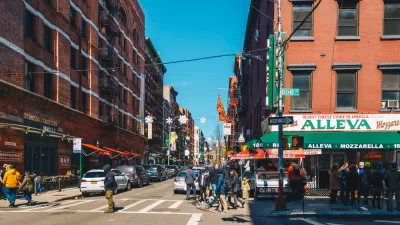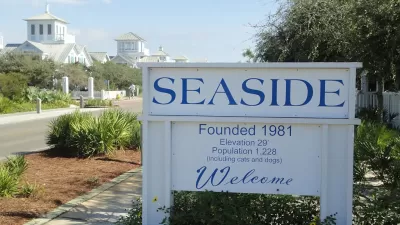While The New Urbanism has certainly helped to change the way people think about how communities can be built, it's still seen as a boutique product. More needs to be done if New Urbanist developments are to really compete with mainstream sprawl.
"Since the movement's pioneering couple, Andrés Duany and Elizabeth Plater-Zyberk, designed the Florida panhandle community of Seaside back in 1980, the number of successful New Urbanist communities has steadily increased across the country. These include "greenfield" projects on undeveloped exurban land and inner-city, government-subsidized neighborhood developments that have replaced dysfunctional Urban Renewal–era housing projects. Still, while the New Urbanism set the stage for the current displacement of shopping malls by pedestrian-friendly, streetscape-oriented "lifestyle centers," the New Urbanist share of U.S. property development remains minute. From tiny "infill" developments in sparsely-settled suburbs or deteriorated city blocks to large-scale urban plans, the project total probably comes to less than 1,000.
And so the vibes at the conference, which took place at the Lyceum in Alexandria and in the Caucus Room of the Cannon House Office Building on Capitol Hill, resembled those of a countercultural cabal. After more than a quarter-century of New Urbanism, proclaimed Stefanos Polyzoides-who, with his wife Elizabeth Moule, heads a top-flight urban-design practice in Pasadena, California-"there's no indication that the system of building in this country is even dented." In other words, sprawl still reigns, and so do the sundry forms of architectural dysfunction afflicting the nation's public realm. The New Urbanists have changed the conversation, but they haven't changed the world. At least, not yet."
FULL STORY: New Urbanists Point the Way Forward

Planetizen Federal Action Tracker
A weekly monitor of how Trump’s orders and actions are impacting planners and planning in America.

Maui's Vacation Rental Debate Turns Ugly
Verbal attacks, misinformation campaigns and fistfights plague a high-stakes debate to convert thousands of vacation rentals into long-term housing.

Restaurant Patios Were a Pandemic Win — Why Were They so Hard to Keep?
Social distancing requirements and changes in travel patterns prompted cities to pilot new uses for street and sidewalk space. Then it got complicated.

In California Battle of Housing vs. Environment, Housing Just Won
A new state law significantly limits the power of CEQA, an environmental review law that served as a powerful tool for blocking new development.

Boulder Eliminates Parking Minimums Citywide
Officials estimate the cost of building a single underground parking space at up to $100,000.

Orange County, Florida Adopts Largest US “Sprawl Repair” Code
The ‘Orange Code’ seeks to rectify decades of sprawl-inducing, car-oriented development.
Urban Design for Planners 1: Software Tools
This six-course series explores essential urban design concepts using open source software and equips planners with the tools they need to participate fully in the urban design process.
Planning for Universal Design
Learn the tools for implementing Universal Design in planning regulations.
Heyer Gruel & Associates PA
JM Goldson LLC
Custer County Colorado
City of Camden Redevelopment Agency
City of Astoria
Transportation Research & Education Center (TREC) at Portland State University
Jefferson Parish Government
Camden Redevelopment Agency
City of Claremont





























